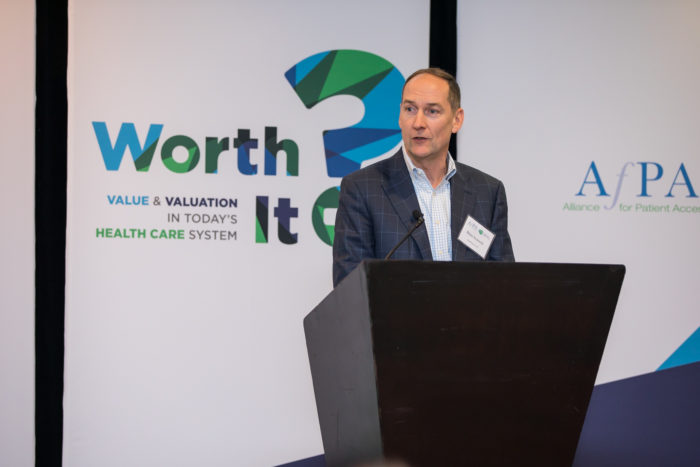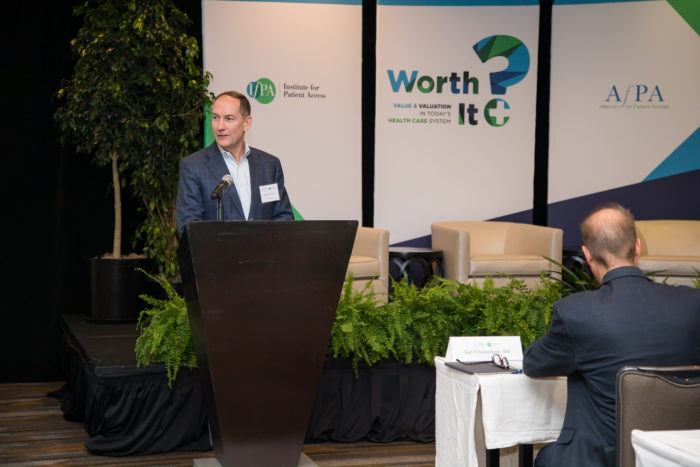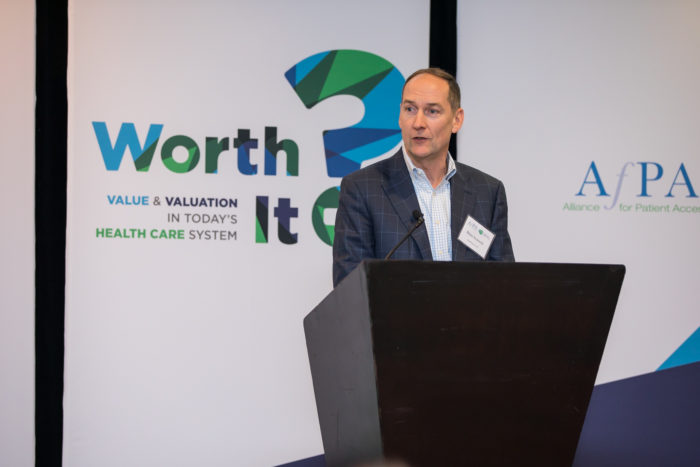AfPA-IfPA Health Policy Leadership Retreat
November 27, 2018
What’s the value of a trusting relationship with a good doctor? A life-altering medication? Choices among medical treatments? These and other topical questions took center stage at the Alliance for Patient Access and Institute for Patient Access’ first-ever health policy leadership retreat, held in San Diego.

Entitled, “Worth it?,” the two-day event combined expert panel discussions, case study analysis and brainstorming sessions to examine value and valuation in today’s health care system. The audience included physician members of the Alliance for Patient Access, as well as advocates, health economists and other stakeholders.
The Physician-Patient Relationship
The event didn’t shy from tough issues. AfPA Chairman David Charles, MD, opened the program with a hard look at the physician-patient relationship. Plagued by burnout, physicians face institutional pressure to squeeze in as many patients a day as possible. They also deal with electronic medical records, which can compel them to look at a screen rather than give their full attention to a patient during an appointment. And then there’s health plans’ utilization management – requirements like prior authorization or fail first, which pile on paperwork and delay physician-prescribed care.
One physician, gesturing to a projected photo of a patient and physician, explained, “We’re doing less and less of that, and more and more of everything else.”
But the group was firm: Despite added pressures, the physician-patient relationship remains a cornerstone of quality health care. Some of its benefits are measurable. As Dr. Charles noted, a strong physician-patient relationship means patients are more likely to take medication as prescribed and more likely to make recommended lifestyle changes such as exercising or quitting smoking. The relationship also correlates with lower ER rates and better mental health for patients.
There are also less tangible, but equally valuable benefits. “Statistics don’t tell the whole story,” one physician insisted. “How do you quantify the value of a 10-year relationship with a patient? Of seeing them go from a whole pack down to two cigarettes a day? It’s baby steps,” he noted, adding “That’s hard.”
Dr. Charles charged the group with advocating for a health care system that protects and reveres the physician-patient relationship.
Value & Valuation
The event also took up questions of value and health technology assessment. In a panel discussion entitled “Searching for Value,” The Pink Sheet’s Nielsen Hobbs spoke with Clara Soh of Avalere Health and Mark Linthicum of the Innovation and Value Initiative on the topic of valuation.

The status quo is problematic, panelists agreed. Soh called current valuation tools “blunt instruments,” noting that value is “very different depending upon who you are.”
On the topic of the Institute for Clinical and Economic Review, Linthicum observed that ICER’s findings “defend coverage decisions rather than support access.” Soh called it “economic malpractice” to conduct a valuation of a product before having all necessary information, which ICER frequently does.
A better approach would incorporate diverse perspectives – data beyond just clinical trials. That might include quality-of-life issues such as a condition’s burden on both the patient and the patient’s caregiver.
Valuation should also function to inform patient and physicians’ decisions – but not to make their decisions for them. After all, participants agreed, valuation is not a one-size-fits-all endeavor.
Drug Pricing & Patient Access
An afternoon panel explored drug pricing and patient access. The Alliance for Patient Access’ Susan Hepworth moderated a panel discussion, arguing that the high price of drugs reflects a broken drug system. Panelists Wayne Winegarden of the Pacific Research Institute and Mike Ybarra, MD, of PhRMA agreed.

Part of the problem is the convoluted nature of the rebate system. “The price you hear about in the news isn’t actually the price that’s being paid,” Winegarden explained, noting, “’How much do drugs cost?’ We should be able to answer that question. But we can’t.”
Pharmacy benefit managers, who push for higher rebates, can create problems of their own. Dr. Ybarra alluded to rebates on insulin being as high as 70 percent of the drug’s price. The problem? Some patients’ out-of-pocket expense is based on a drug’s list price. So even if aggressive rebate negotiation drives down the net price of a drug, that won’t make it less expensive for patients. Co-pay assistance from manufacturers can help patients. But, as panelists noted, the increase in co-pay accumulator programs are making that complicated.
What is working? Competition, argued Dr. Ybarra. He alluded to the FDA’s success in streamlining and quickening the pace of drug approvals. He added, “Negotiation does happen in the health care system.”
Participants noted that, as with valuation, pricing decisions should include input from diverse stakeholders. Patient access should be a key consideration, the group agreed, but all parties should be ready to share both the risks and the benefits of prescription medications.
Real-World Implications
As a follow up to both panel discussions, participants analyzed hypothetical case studies. The situations sparked debate about how much financial responsibility patients should bear, how physicians should handle tough prior authorizations, and how physicians should advise patients who are in tough financial situations that affect their treatment.

Because, while the event explored issues from a policy lens, “These issues impact real people,” AfPA Executive Director Brian Kennedy reminded the group. AfPA members plan to use principles that arose from the discussion to inform policy and advocacy work moving forward.
Tags: Cost Value

























